Is Bona Naturalseal changing my stain color? please help
I finally decided on a stain combination that I’m very excited about using on our newly installed white oak floors. I chose Duraseal 2 parts Weathered Oak to 1 part Special Walnut and decided on Bona Traffic HD satin. I read that a sealer must be used with white oak, so I had the installer apply Bona sealer and Poly to the stain sample on the floor. The sample poly was Mega One, not the Traffic HD. I don’t know if that makes a difference on the sample. It may have been all he had today, but I’ll make sure he applies Traffic HD on actual coats. The problem is the stain colors that I loved so much have lightened and changed significantly. The stain color appears lighter, less saturated, and less brown than the original. In addition to that, the sheen level appears shinier than I think satin should be. The installer used Bona Naturalseal and there are boxes on the front that appear to indicate something. Clarity level? Could this product be what is making the stain color appear lighter? The liquid appears murky, not clear, so it would make sense that perhaps it’s what is lightening the color. And if it’s more white, maybe it’s reflecting light that makes the satin poly appear shinier?? I will make sure that he applies Traffic HD to the floor when he applies poly, but I wanted to be clear here about what products were applied to the sample, because I need to figure out why the color changed and lightened. I strongly suspect the problem is some color in the seal that’s lightening it. Am I correct and can I achieve that original sample color if I avoid using sealer and go straight to poly? Sorry for the long explanation. Trying to be concise and clear.



Comments (37)
Allie
Original Author3 years agoThe first picture is the stain sample I love of Duraseal 2 parts Weathered Oak to 1 part Special Walnut. No poly or seal on it. Just stain.
In the second picture, the installer had added that the Bona Naturalseal to the whole sample, but on the right half he applied a Duraseal water-based poly, so I could see the difference. I don’t want the Duraseal poly, but just wanted to explain why the right half may look different. I’m hoping that my pictures adequately reflect the color and saturation change. It is significant in person to me and I’m very disappointed. It’s less brown and possibly more transparent. Again, the sealer was a milky white color. Should it be clear? And do I even need it at all if I’m applying stain to the white oak? Can I just do the stain and go straight to the Traffic HD poly?
The 3 pic is of the products applied to the sample. Note the boxes to the right on the bottle.
Thank you so much to anyone taking the time to reply.
SJ McCarthy
3 years agoWhite Oak does not need a sealant if you are using a sealing stain (like DuraSeal). You can see the snick of yellow tone the NaturalSeal adds to wood (it is in the picture on the bottle). You can use Traffic HD (two or three coats...your call but 2 coats can look 'thirsty' afterwards...it just depends on the application/skill of the installer) directly over the stain.
Related Professionals
Elkridge Flooring Contractors · Freeport Flooring Contractors · Parma Heights Flooring Contractors · Tucson Flooring Contractors · Ames General Contractors · Belleville General Contractors · Chatsworth General Contractors · DeKalb General Contractors · Foothill Ranch General Contractors · Greenville General Contractors · Lewisburg General Contractors · Longview General Contractors · Monroe General Contractors · Nampa General Contractors · University Heights General ContractorsAllie
Original Author3 years agoThank you so much for your reply. I will skip the sealant and do 3 coats of Traffic HD. If I do so, will it go back to the original color of the sample in the first picture? My pictures may not accurately reflect the color change, but it’s significant. Is the yellow in the sealant the culprit?
G & S Floor Service
3 years agoNaturalseal is a pigmented sealer. The pigment is white, which is what caused your stain to lighten. Unless, it is the look you want, skip the sealer as SJ suggested and go directly with poly.
Allie
Original Author3 years agoThank you very much. That’s exactly the answer I was hoping for. You’ve both been a huge help. I’m so relieved!
Allie
Original Author3 years agoHate to bother you guys again, but this stain process is nerve wracking and a bit nauseating. Please help me. They applied the stain upstairs and on the stairs. I have white oak. I wanted a medium chocolate brown stain with some smokey gray and soft grain lines, which I thought I accomplished in 1st pic with 2 parts weathered oak and 1 part special walnut. 2nd pic is the same sample in different lighting. Looks more gold but still med brown and I still loved it and thought it worked. Of course, now that stain is down over a larger area and different lighting, I’m trying not to panic. It looks so different. I see red (or orange?) streaks, various shades of brown and yellow. Now I wonder if the floors are too light and won’t provide enough contrast. The ceilings are high in the main living area (20 feet and almost 30 feet at the stairs/turret). There’s a lot of light in those areas. The walls and ceiling will eventually be painted and go lighter. I’ll share pictures of the upstairs hallway and loft/landing, the stairs, and the unfinished downstairs. Installer suggested if I wanted to go darker, to switch from water based to oil based poly and he said he could add a little bit of dark stain to the poly, but how would we begin to predict what that would do to the color? Please tell me the stain will develop more to look like my sample pictures as it dries and maybe even more so after we add poly.
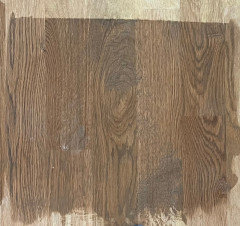
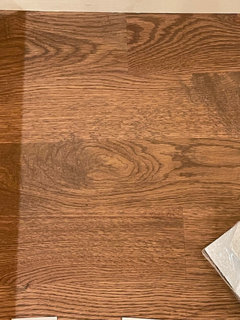

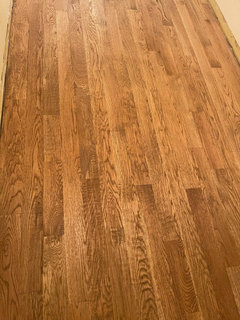
Allie
Original Author3 years agoThe stain seem so light on the stairs. Think it will get darker as it dries? And appear darker if we lighten the paint color?




Allie
Original Author3 years agoAnother pic of the stairs and one overlooking the living area below that is still unfinished.
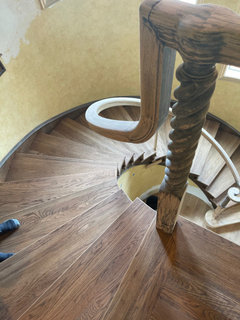

G & S Floor Service
3 years agolast modified: 3 years agolook At it after sundown. You have bounce lighting from the paint and windows.
was the sample waterpop?Allie
Original Author2 years agoNo, the sample wasn’t water-popped. We decided not to water-pop. I think you’re right about the light from the paint and windows changing the look. I did have them add more stain to the stairs. They were way too light, but much better now.
They still have to do 1 or 2 more coats of poly (Bona Traffic HD) downstairs, but I’m noticing a white line around the perimeter of the rooms. Is this normal? Does it go away after additional poly coats are added? Anything to be concerned about?




Allie
Original Author2 years agoWhat caused it? Will I know if it’ll blend once it dries in 30 minutes? If it doesn’t blend, how do they fix it? Will they have to resend and start over?
Thank you so much for your help.
SJ McCarthy
2 years agoYou added more stain to the stairs? You are aware there is a HUGE chance the poly won't stick with 2+ coats of stain, right?
Allie
Original Author2 years agoNo, I wasn’t aware of that. No one mentioned that could possibly happen. I’m not the flooring professional, so how could I know? This is a nightmare. What now? How do I know if the poly on the stairs will be an issue? And can anyone please enlighten me on what caused the large white lines around the perimeter of some of the rooms? I assume it has something to do with a machine used (sanding, buffing?), but please clarify. What did they do wrong?
Allie
Original Author2 years agoNot that it matters, but the first attempt at stain on the stairs was SO light, I’m not even sure it qualified as a first coat.
G & S Floor Service
2 years agoIt is usually caused from the sanding process. The contractor needs to blend in the field and edges better on the final sanding. But based on your photos, the contractor might have tried to lighten it with mineral spirit, which is causing the white. You will see the result after the first coat has dried. Then, you can try and spot fix or start over from the beginning.
Allie
Original Author2 years agoThank you very much for your help. I can only hope they didn’t use mineral spirits on the edges. We never complained or were aware of any issue with the edges being dark, so I can’t imagine why they would use mineral spirits to lighten them. Was just looking over a text from them and it appears they’ve done 2 coats of poly already, so only 1 coat left to apply. Do they do the final sanding before or after that last poly coat? I guess I’ll ask them about it when they get here tomorrow morning. Hopefully they’ll have a reason for it and a plan to blend it with the final sanding.
About the stairs, what are my options? They were SO light before. Honestly, I can’t remember if they offered to add more stain or if I asked if they could, but either way, they said yes and did so without any word of caution to me about it affecting the adhesion of poly. How would you proceed from this point? I don’t know if they have put any poly on the stairs yet. Do I have them sand and re-stain once or apply poly and see what happens? Would I know if there is an adhesion issue right away or is it the kind of thing that could be an issue in a year or two?
Allie
Original Author2 years agoThe first picture shows how light the stair stain was and the second is how they look with additional stain applied. I know the lighting is a bit different but the first application was so light, it didn’t look good to me. The wood used on the stairs, while it is also white oak, seems different. It was thicker for sure. I don’t know if that affected the way the stain absorbed or if they didn’t leave it on long enough. Are there ways to adjust how dark a stain goes on? Does applying a heavier coat or leaving it on longer affect how dark or light a stain appears?

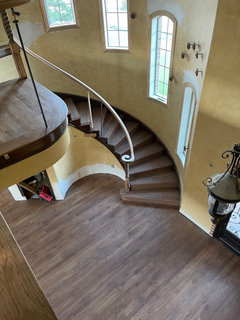
Allie
Original Author2 years agoAlso, in the first pic, the stairs were stained, but the bottom step and floors were not yet stained. Just wanted to clarify. In the second pic, all steps were stained (with additional stain added) and 1 coat of stain on floor.
SJ McCarthy
2 years agoAre there any other areas that received more then one cost of stain?
If the homeowner asks for something and it doesn't work (ie. More stain causes adhesion failure = needs to be redone) it *can be argued the homeowner is responsible for any/all repairs. The GC can argue, "The customer is always right."Allie
Original Author2 years agoThe stairs are the only place to receive more stain to my knowledge. I didn’t ask for more stain anywhere else and I’m not even sure I asked for more stain on the stairs. I admit to voicing my dismay that the stairs were so very light, but I don’t recall specifically asking for more stain. I think they asked if I wanted to them add more stain and I said “oh, you can add more stain?” However the conversation evolved, I would hope that I could count on a professional to tell me what can or can’t be done. If I asked for a hair treatment that would damage my hair and make it fall out, surely the hair dresser would at least be obligated to warn me of what could happen. I didn’t insist on more stain and I would never knowingly be fine with doing anything that would cause the very expensive stain and poly on my stairs to fail. This is an investment and I have the most to lose if it’s not done right. How would you proceed from here? Would you say the safest option is to re-sand and re-stain the stairs? Or have them poly and see what happens?
And thank you so much for your help.
G & S Floor Service
2 years agolast modified: 2 years agoDo a adhesion test on the staircase. Score cross hatches "x" , stick blue tape on it and pull. Then check for any peeling. Any peeling - redo, none, then touch up the score marks.
Regarding white spots, if, that is how it looks like after two coats of poly. Then, it is not acceptable. It needs to be redone.
Upon taking a closer look at the stained floors. Are those hand scraped floors?SJ McCarthy
2 years agoThe 'white edging' is an issue as G&S states. That's not acceptable. It looks like it is the area where the sanding machine was unable to get to...but the palm sander was supposed to deal with. The effect is quite startling.
It sounds like you have a General Contractor doing the work and not a full-on wood flooring professional. Or if you hired a wood flooring pro, it looks like s/he has the B-team working on your floors.
A newbie to the wood flooring industry would not know that two coats of stain are an issue. And a newbie (or General Contractor using one of his 'hammer swingers') would not know how to deal with the cut-ins at all the walls. You have both issues happening here.
Whomsoever you paid (GC or floor pro, or flooring company) needs to stop and have a chat with you. If the B-team is on site, don't talk to them...talk to their boss. If it is the GC who has sent in hammer swingers, don't talk to the dudes working the floor, talk to the GC him/herself.
I'm sorry this is happening. We see 'flooring hacks' all the time. It is hard to figure out who's a pro flooring person and who's a hack. In General (but not always) a GC will NOT hire a flooring pro. They are too expensive.
If you need some local help to figure out what needs to be done with your floors (ie. NO ONE is listening to your concerns and they keep insisting on being paid for work already done), you can hire an NWFA Certified Flooring Inspector. This is normally a last-ditch effort. You can use the THREAT of bringing one of them out...They write reports that are detailed and are 'court ready'. Anyone who's anyone in the building business knows they are in a heap of trouble if the homeowner hires one of these guys. It is often enough to threaten an inspection. That will get you a real conversation.
You want to put any convo in writing. You can summarize via text or email - with photos of what you spoke about. That is another way to 'hint hint' that you are documenting everything that is going on.
If you are determined to get an inspection by a 3rd party:Allie
Original Author2 years agoYes, they are hand scraped floors. One of the guys is here now hand sanding all along the edges before they put on the final (3rd coat of poly). Do they have to sand in between coats of poly? If so, do they only sand the edges? Or should I expect them to sand the rest of it before another coat of poly goes down?
This is a flooring crew/pro, not a GC. I used them in the past to refinish my floors and they did an excellent job. I had to hire them again because a failed roof caused water damage and mold, so we had to replace the water damaged floors. I thought I was in good hands (although I was panicked about my stain color decision) until you guys pointed out the possible issue with the stairs and then I noticed the white band around the perimeter of the room.
I’ll do a little more research. Perhaps they sand the whole floor between poly coats? Or before the last coat? The fact that you two are concerned causes me alarm.
Allie
Original Author2 years agoThat’s exactly what they were doing. Once the final coat was applied, all of the buffing was gone. I have a few new concerns now that they claim to be finished. Would you please give me your thoughts on these issues/concerns? The floors are lightly hand scraped, but what is shown in the pictures is not supposed to be there. The 3 pics below are in an area on the main floor near the stairs. They won’t be covered by a rug. These marks are also in another area near the stairs. Two prominent areas that I know of. It’s hard to see when you’re standing directly over it, but when you take a couple of steps away, you can easily see it. Any idea what caused it? It had to be a piece of equipment or some of their tools.
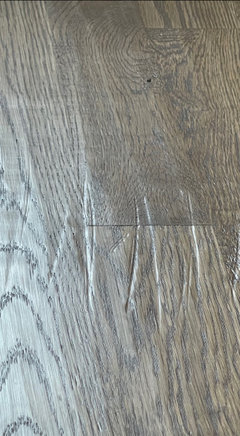


Allie
Original Author2 years agoThis is in the middle of the mud room floor. A pretty large 7” long gash in the floor. I have no idea what caused it, but they stained and polyed right over it. I would think it would be hard to miss.

Allie
Original Author2 years agoIs there a normal way for the gap between each stair and riser to be handled? What about where each step meets the wall? There are gaps there that aren’t filled with anything. Should it be caulked or filled with wood putty? Who typically handles that? The floor crew or would I have painters caulk it? Honestly, I’d rather the wood floor guys make it look right than to hope a painter would caulk it correctly, but perhaps it’s not something a flooring crew usually does?
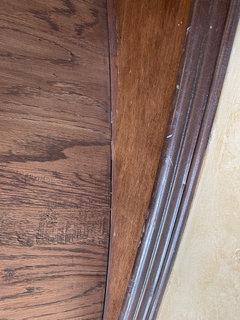
Allie
Original Author2 years agoWhat about areas like this? They undercut my kitchen cabinets and overall they did a great job. They had to replace a few toe kicks, which was no big deal, but there are a couple of places where it’s missing wood (or filler?) Because it’s on the floor itself, I didn’t think it would be something the cabinet people could correct, but maybe I’m wrong? The cabinets will be caulked where needed and painted. Just don’t know that caulk would correct these issues. Is there anything I could ask the floor crew to do to fill the holes?



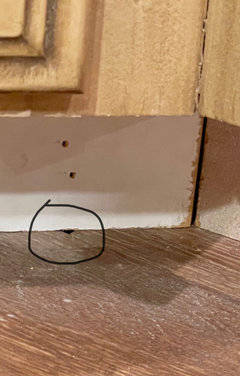
Allie
Original Author2 years agoOverall, for the majority of the floor, you see no nail holes. In other words, because they aren’t there on most of the floor, I’m surprised to see clusters of them here and there. Before final poly when I would ask about them, I was assured by the main guy that he would check everywhere and take care of them. Now that the final coat of poly has gone on, I see clusters of nail holes in areas. This is in my kitchen. I put a tiny piece of blue tape beside each hole. It’s very noticeable to me. There’s a cluster upstairs in the loft, and several near doorways. If it were 1 or 2 here and there, I could live with it (and maybe I’ll have to), but so many of them clustered in areas makes them more noticeable. Thoughts?


Allie
Original Author2 years agoOn the stairs, there are lines that look like tiny cuts going across and down them. Whatever made these marks, they aren’t part of the hand scraped look. I don’t know if someone drug a piece of equipment down the stairs or what, but I notice the marks/cuts. You may have to zoom in and even still, I don’t know that I captured them very well in the pics. I could live with it if I have to. It’s probably the least of the concerns, but it is noticeable and the curved stairs are sort of a highlight and I was not happy to see all the tiny cut marks. Any idea what might have caused it? A piece of equipment? A tool?



Allie
Original Author2 years agoThe guys also worked on our handrail/banister. They applied black gel stain and poly. In the process they tracked gel stain onto the wood floor, even though they put paper down around the area they worked. He got up most of the gel stain, but I still found a few black gel stain spots. I can only assume they were polyed into the floor with that final coat. Is there any way he can remove the gel stain if it was in fact polyed in?
Allie
Original Author2 years agoI’m about to discuss these issues with him as he thinks his job is done and he wants the final payment. I’m torn. I don’t want to be a nightmare customer and I think correcting some of these is a big deal. I don’t know how easily things can be corrected. Can they lightly sand, remove/replace some boards (stain and blend them), apply filler to holes, and then repoly once? We agreed to pay for 3 coats of Bona Traffic HD, so starting over with sanding, scraping, and 3 coats of poly seems like a big deal if that’s what they have to do. Again, I don’t want to have expectations of perfection that are unattainable. I want to be fair. At the same time, I don’t want to feel like I’m driving a brand new car out of a car dealership with scratches and dents on it. Would you please give me your thoughts? I don’t know if it’s reasonable to ask for these things to be corrected or if I need to just call it a day and move on. Thank you SO much for reading and any input. You are both invaluable and I’m so grateful for your help.
G & S Floor Service
2 years agoYou have handscraped. Those marks are from the onsite handscraping. It’s acceptable for the look. Only way to avoid it is to hand scrape prior to installation. I would fill holes And gaps . The baseboards and toe kick will need to be scribed for a tighter fit.
Allie
Original Author2 years ago@G & S Floor Service, thank you very much for your help. The only thing I might respectfully disagree with you on is in regards to the first 3 pictures (and arguably the gauge in the mudroom). I’ve had hand scraped floors before and never had (or seen) marks like those. Also, those marks are there and in one other place nearby and they look nothing like the “light hand scraping” everywhere else in the house. It looks like they drug a giant pitch fork along the floor twice. I’m trying to decide if we could get away with leaving them. That’s what I’m not sure of since it’s only in those 2 places and they’re so different. You can’t see it when standing directly over it, but you definitely see it and know it shouldn’t be there when you take a step or two away from it.
Can the guys still fill holes and gaps now that final poly was done? And by filling gaps, are you also referencing the space between stairs and risers as well as where the stairs meet the wall?
I really like the main guy and his entire crew. They’re great guys and have tried to make me happy. I want to be reasonable in my expectations and while I definitely think those
Allie
Original Author2 years agoDid finish my last sentence....I definitely think the marks are an issue, if extremely difficult to fix, I want to be understanding.
G & S Floor Service
2 years agoHopefully, you are not comparing pre-finished hand scrape to site finished hand scraped. You will get two different looks. Prefinished hand scraped are individual boards. There is no continuous scraping marks that leads into other boards. Each board looks unique. Site finished, the entire assembly is one piece. The scraping continues into nearby boards, joining it to one another.
You can alter the depth of the marks, by re-scraping it. Or sand it completely off and re-scrape it. You will end up with a low spot in that location. I do not see a big gain from redoing it.
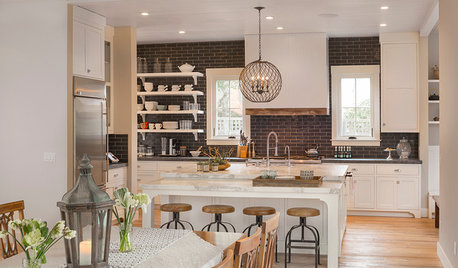
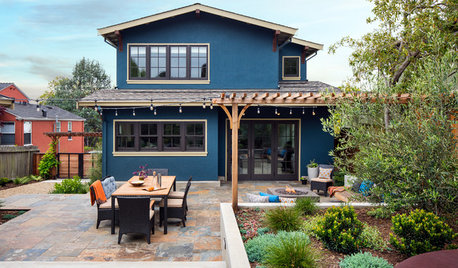





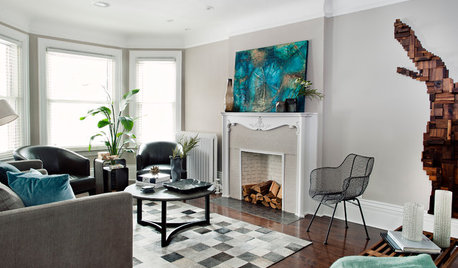








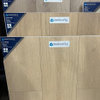
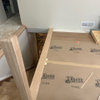

G & S Floor Service